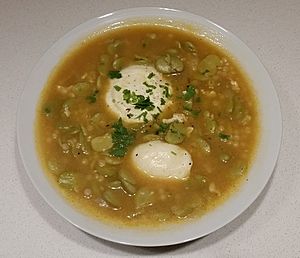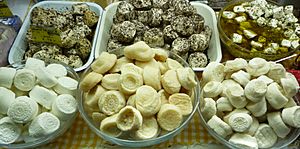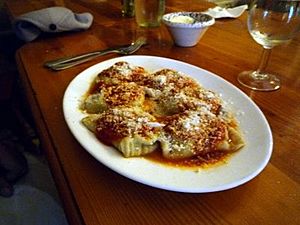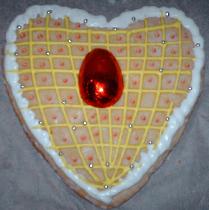Maltese cuisine facts for kids
Maltese cuisine is like a delicious history book! It shows strong influences from Italy, Spain, France, and other Mediterranean cuisines. Later, some British cooking styles also joined the mix.
Malta had to import most of its food. Being on important trade routes and hosting foreign rulers meant its food was open to many outside ideas. The traditional Maltese rabbit stew, called stuffat tal-fenek, is often seen as the national dish.
Contents
How Malta's Food History Shaped Its Dishes
Malta's long history and its location in the middle of the Mediterranean Sea greatly shaped its food. Since Malta needed to bring in most of its food, and because it was a busy trading spot, many different food traditions arrived. Foreign dishes and tastes were welcomed, changed, and made into something new.
Foods from Italy (especially Sicily), the Middle East, and Arab countries had a big impact. Later, the Knights of St John and the British brought even more flavors from far away.
Knights and New Flavors
The Knights of St John came from many European countries, like France, Italy, and Spain. They brought their own food traditions with them. For example, Aljotta is a fish soup with garlic, herbs, and tomatoes. It's Malta's version of a French soup called bouillabaisse.
The Knights' connections and wealth also brought food from the New World. Some people think Malta might have been one of the first places in Europe (after Spain) where chocolate was tasted!
British Influence on Maltese Cooking
The British army's presence in Malta created a market for British foods. Later, many tourists from the UK also visited. British food items like English mustard, Bovril, HP Sauce, and Worcestershire sauce are still quietly used in Maltese cooking today.
Some foreign words for food also changed in Malta. The Maltese word "aljoli" is a version of "aioli," a sauce found around the Mediterranean. The Maltese "aljoli" is made with herbs, olives, anchovies, and olive oil. Also, the Maltese word "taġen" sounds like "tajine," but in Malta, it just means a metal frying pan.
Maltese Food and National Identity
Maltese food has some interesting connections to the country's identity. The traditional Maltese stuffat tal-fenek (rabbit stew) is a great example. It's often called the national dish. This dish might have started as a quiet way to protest hunting rules set by the Knights of St John.
Rabbit stew became very popular after these rules were lifted in the late 1700s. By then, local rabbits had grown in number, and their prices dropped. Also, people learned how to raise rabbits, a skill that might have come from French Knights.
Pork and Cultural Identity
The popularity of pork in many Maltese dishes could be because Malta was on the edge of the Christian world. Eating pork, which is not allowed in Muslim food culture, might have been a way for Maltese people to show their own identity.
Besides grilled pork or stuffed pork, adding pork to dishes like kawlata (a vegetable soup) and ross il-forn (baked rice) has been common for centuries. This shows how important pork was in traditional Maltese cooking.
A Special Pastry
For the Café Europe event in 2006, Malta chose the maqrut as its special pastry. This shows how certain foods become symbols of a country's culture.
Different Kinds of Maltese Food
Even though Malta is a small country, its food has some regional differences. This is especially true for the island of Gozo. You can see this in names like the Gozitan cheeselet (ġbejna t'Għawdex) and ftira Għawdxija. This ftira is a flatbread topped or filled with potatoes or ġbejniet. Other possible ingredients include eggs, grated cheese, tomatoes, anchovies, olives, ricotta, and Maltese sausage.
Gozo also uses ingredients differently. For example, Gozitan cheeselets are used to fill ravioli there, instead of the usual ricotta cheese.
Seasonal Sweets and Dishes
The biggest food changes happen with desserts and sweets, depending on the season. Prinjolata, kwareżimal, karamelli tal-ħarrub, ftira tar-Randan, figolla, and qagħaq tal-għasel are all sweets linked to a specific time of year.
During Lent, a time when Catholics traditionally fast from meats and dairy, fish like Lampuki were popular. Other dishes eaten during this period included stewed snails (bebbux), stuffed artichokes (qaqoċċ mimli), and fritters (sfineġ) made from ġbejna, vegetables, or fish like whitebait and salted cod.
Around Holy Week, bakers make a large bagel called qagħqa tal-appostli (apostles' bagel), often with almonds on top. This time also usually matches with spring, bringing seasonal changes to dishes. For example, fresh broad beans are added to dishes like kusksu (a vegetable and pasta dish).
In November, people prepare għadam tal-mejtin (bones of the dead). These are sweet pastries with a layer of marzipan inside and white icing on top.
Qagħaq tal-Għasel: Honey Rings
Qagħaq tal-Għasel, or honey rings, are a famous Maltese sweet. They are made of pastry with a dark, sweet filling inside, shaped into a ring. Small cuts along the ring let the filling peek out. The traditional filling is a mix of honey, molasses, aniseed, cinnamon, and cloves. Some people now add cocoa powder for a hint of chocolate.
Even though honey rings were traditionally made for Christmas, they became so popular that people now make them all year. Many don't even know they were originally a Christmas treat! This sweet also has a special meaning. The ring shape means "eternal happiness," and because the filling oozes out, it means "overflowing with goodness."
See also
 In Spanish: Gastronomía de Malta para niños
In Spanish: Gastronomía de Malta para niños






